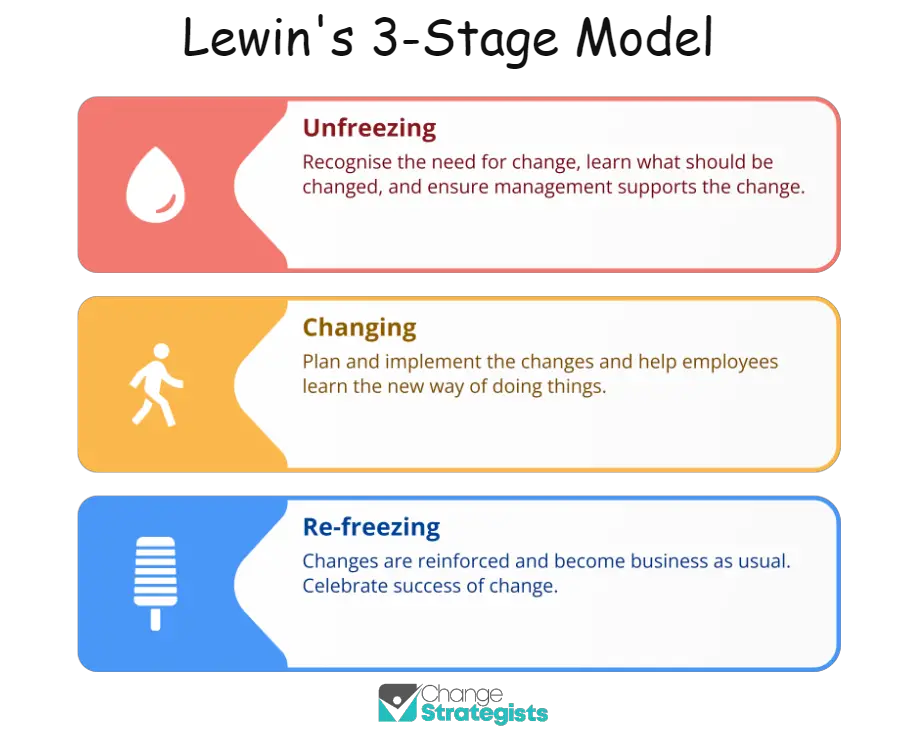Change is an inevitable part of life, and understanding the process of managing it can be daunting. Kurt Lewin’s Change Model was developed to provide a framework for understanding how change happens, and has become one of the most widely accepted theories in organizational change management.
In this article, we will explore Lewin’s Change Model, from its origins to its three-step process. So grab your thinking caps and let’s dive into Kurt Lewin’s groundbreaking theory on how to effectively manage change!
What is Kurt Lewin’s Change Model?
Kurt Lewin’s Change Model is a widely accepted theory of organizational change management. Developed by social psychologist Kurt Lewin in the 1940s, this model provides a framework for understanding how change occurs.

It suggests a three-step process:
- Unfreezing the current state of affairs
- Changing to a desired state
- Refreezing the new state
This model has been used by social scientists, business leaders, and senior management to help address various business challenges and foster effective organizational development.
Lewin’s model is based on his field theory, which states that behavior is driven by both person and environment factors. His topological psychology studies how people interact with their environment to create common ground or find balance between different situations.
The American Psychological Association awarded Kurt Lewin with its highest honor – the Gold Medal Award for Lifetime Achievement – in recognition of his contributions to the field of psychology.
His books “Field Theory in Social Science” (Harper & Row) and “A Dynamic Theory of Personality” (Prentice Hall) remain essential reading for social psychologists today.
Business leader Carlos Ghosn recently credited Lewin’s Change Model as playing an instrumental role in his success at leading Nissan Motors out of crisis.
The Change Model by Kurt Lewin has revolutionized how organizations approach change and development, making it an essential tool for any business leader looking to drive successful outcomes. But what is Change Management Theory? Read on to find out!
What is a Change Management Theory?
A change management theory is a system of processes, tools and techniques used to efficiently manage changes within an organization. It aims to ensure that changes are implemented in a smooth, effective, and timely manner.
Change management theory addresses the people side of change while also taking into consideration the organizational structure and culture. It is focused on creating a cohesive team effort to make sure the desired results are achieved.
This includes motivating employees to accept and embrace the changes, providing training when necessary, communicating with stakeholders, building trust among teams and implementing strategies for successful change implementation.
It is important for organizations to have an effective change management system in place as it can help reduce employee resistance and minimize disruption throughout the process.
Origins of Lewin’s Change Model
The origins of Kurt Lewin’s Change Model can be found in the field of social science, particularly psychology. In the 1930s, Lewin was one of the pioneering social psychologists to embrace field theory, which focused on analyzing interactions between individuals and their environment. His work made a major contribution to the development of topological psychology and furthered his influence in the American Psychological Association.
Lewin published his first book on change management theory in 1951 titled “Field Theory in Social Science”, which was published by Harper & Row. The book provided an explanation for how an individual or organization could successfully manage change and make progress towards desired goals. Prentice Hall then published revised editions of this book with new insights from additional research conducted by Lewin and other social scientists.
Today, Lewin’s Change Management Model is widely used by professionals to guide organizations through change processes, such as those led by Carlos Ghosn at Nissan Motor Company or those experienced during periods of organizational development.
The model emphasizes creating a sense of urgency among stakeholders, identifying common ground between teams, using field analysis to understand relationships between systems and processes, and involving senior management at every level of decision-making. It is an effective tool that can help businesses address their challenges while still remaining open to new ways of thinking.
What is the difference between Lewin’s model and Kotter’s model?
Two models that have gained popularity in the field of change management are Lewin’s model and Kotter’s model, but what is the difference between the two? Let’s break it down.
Lewin’s model is a three-step change management model that emphasizes the importance of unfreezing the current state, making changes, and refreezing the new state. Kotter’s model, on the other hand, is an eight-step change management model that emphasizes the importance of creating a sense of urgency, building a guiding coalition, developing a vision and strategy, communicating the change vision, empowering others to act on the vision, creating short-term wins, consolidating gains and producing more change, and anchoring new approaches in the organization’s culture.
While both models aim to facilitate change, they differ in their specific approaches and emphasis. We’ve already covered Lewin’s three stages: unfreezing, changing, and refreezing.
Kotter’s model consists of eight steps:
- Establish a sense of urgency
- Create a guiding coalition
- Develop a vision and strategy
- Communicate the change vision
- Empower others to act on the vision
- Create short-term wins
- Consolidate gains and produce more change
- Anchor new approaches in the organization’s culture.
Kotter’s model is more dynamic and acknowledges that change is ongoing, and therefore requires constant effort to maintain and improve.
While both models have their strengths and weaknesses, the main difference between them lies in their approach to change. Lewin’s model is more focused on the process of change, while Kotter’s model emphasizes the importance of leadership and communication in implementing and sustaining change.
In the end, the choice between the two models depends on the specific situation and the goals of the change effort. But one thing is clear – change is inevitable, and we must be prepared to adapt and evolve. So let’s embrace change, whether we’re eating pancakes or transforming our careers and businesses.
What are the key stages of Kurt Lewin’s Change Management Model?
Kurt Lewin’s Change Management Model involves three key stages: unfreezing, implementing lewins change model, and refreezing. Unfreezing involves recognizing the need for change, while implementing lewins change model focuses on making the change happen. Refreezing involves establishing the change as the new norm within the organization.
Final Thoughts
In conclusion, Lewin’s Change Model is an effective tool for guiding organizations through change processes.
It emphasizes the importance of creating a sense of urgency and involving senior management at every level of decision-making.
When combined with Kotter’s eight-step model, it offers a comprehensive approach to implementing and sustaining change by emphasizing both the process of change and the importance of leadership and communication.
Ultimately, no matter which model you choose to use, successful organizational change requires careful planning, dedication, and perseverance.





